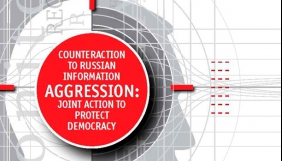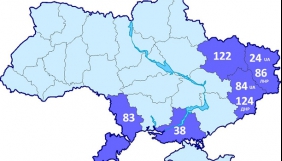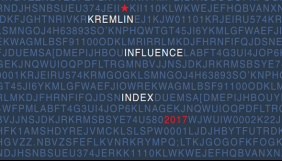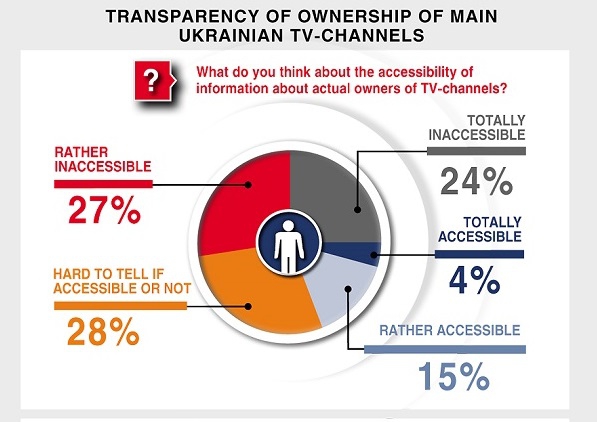
Survey «Attitude of population to media, propaganda and media-reforms during the conflict time»
Survey «Attitude of population to media, propaganda and media-reforms during the conflict time»
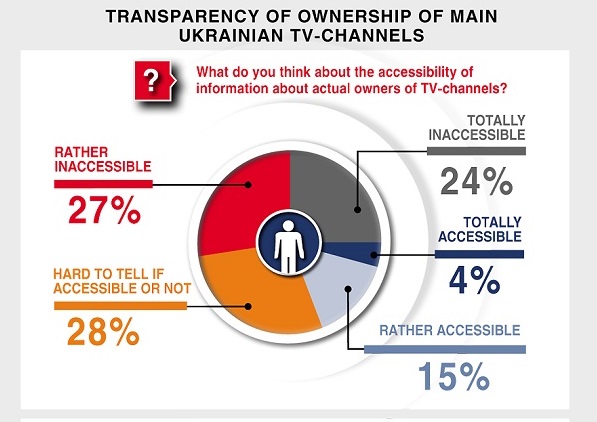

More than one year ago dramatic changes occurred in Ukraine. Revolution of Dignity happened; new leaders declared democratic changes and reforms; new-born country tried to stand against Russian military and psychological aggression. In 2015, how all these shifts affected media literacy and culture of media consuming? What is a trace that Russian propaganda left in Ukrainians’ mind? Has Ukrainian media landscape moved closer to democratic standards?
The survey held by KIIS and Telekritika in June 2015 was to cover such issues as: transparency of media ownership and citizens’ awareness of media ownersip; credibility to Ukrainian media and structure of media consuming; influence of Russian propaganda on Ukrainians’ views; share of local media in media consuming. Here are the result of this opinion poll.
The survey was conducted from 20 May till 2 June. The sample is the adult non-institutional population of Ukraine except the occupied Crimea. The «DPR» and «LPR» territories were also covered by the research, though due to the objective impossibility of random selection in villages and cities of such territories, the interviewers worked in accessible and relatively safe settlements. Thus, the data from «DPR/LPR» are not strictly representative. Total number of respondents at the field stage is 2 022 persons interrogated by means of face-to-face interview, the sample without the territories beyond the control is 1 894 respondents. The maximum sampling error is 3.45%.
Part 1. Ukrainians Do Not Know Who Owns TV-Channels.
The majority of Ukrainians know nothing about the owners of Ukrainian TV-channels. Moreover, the interest to this matter is not very high either: only one third of respondents say that they need to have access to such information.
One of the important components of media reform in Ukraine is to ensure the mass media ownership transparency. So far, even the experts find it difficult to define actual owners of media. But since the owners influence the editorial line of their media, it is important to understand whose interests a channel, radio or periodical represents in order to have critical analysis of media.
The survey helps understanding the awareness of Ukrainians about the ownership of media and if this information is important for them. As the TV is the most popular media – the majority of population watches TV – it was decided to have case-study of several main Ukrainian TV-channels.
The respondents believe that mainly the Ukrainian media owners define the editorial line. 45% believe that the owners influence the media the most, 21% that the State, 11% that the journalists and editors do that on their own. Only 4% told that the editorial line is defined by the public at first, and 18% have no certain opinion on this matter.
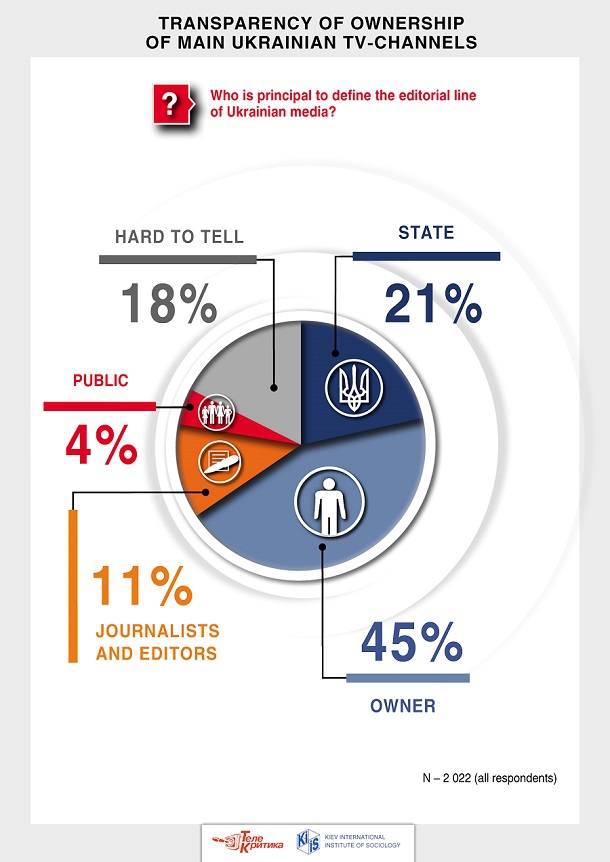
Only 19% of respondents think that the information about actual owner of TV-channel is completely or rather accessible. 51% of respondents told that the information is rather or completely inaccessible, 28% do not know if it is accessible or not.

But not everybody finds the inaccessibility of information about actual owner of TV-channel to be a problem. The society is not convinced that they have to know who owns a channel. 34% of respondents told that it is very or rather important for them to know the actual owner of TV-channels they watch. Whereas this issue is rather not important or not important at all for 40%. 25% have no clear position on that.
64% of those who say that it is very or rather important for them to know the actual owner of TV-channels they watch believe that this information is rather or totally accessible. Thus, about two thirds of TV-viewers interested in the ownership transparency feel the shortage of such information.
To understand the knowledge of Ukrainians about the ownership of TV-channels, the respondents were asked to answer who owns each of the short-listed TV-channels (if a respondent watches it once a week at least). The respondents answering 'private owner' were asked to specify the surname (without any hint).
For TV-channels '1+1', 'Inter', 'Ukraine', 'Channel 5' and ICTV – from 62% to 74% respondents (those who answered the questions) told correctly that these channels have private owners. The viewers know the best that 'Channel 5' is privately owned. From 23% to 34% could not answer.
The opinions of viewers of Pershyi Natsionalnyi (First National TV-channel) differ: 43% believe that it is State-owned, 19% that it is privately owned, 37% cannot answer. It turns out that the ownership of 'Hromadske TV' is the most unclear for Ukrainians: 35% think that it belongs to the civil society, 27% think that it has private owner, and 34% cannot answer.
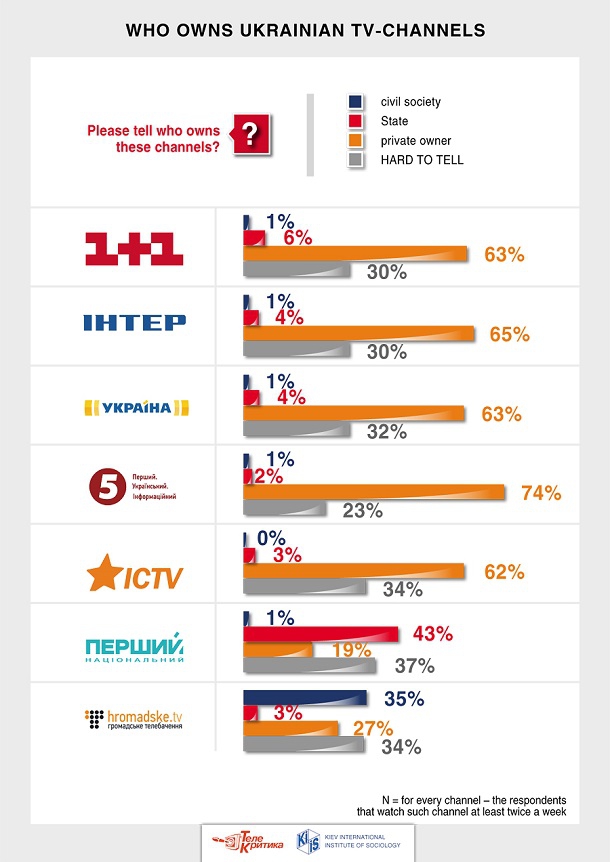
'Channel 5' has the highest rate of respondents who can tell its private owner. 76% of those who watch 'Channel 5' at least once a week and know that it is privately owned indicate Petro Poroshenko spontaneously.
Channel 'Ukraine' holds the second place. 42% told that it is owned by Rinat Akhmetov. Then, '1+1' with 34% indications of Igor Kolomoiskyi, and 'Inter' with 30% naming Dmytro Firtash. Just 16% know that ICTV is held by Viktor Pinchuk. Almost nobody of those believing that Pershyi Natsionalnyi and Hromadske TV are private channels have any idea of their owners.
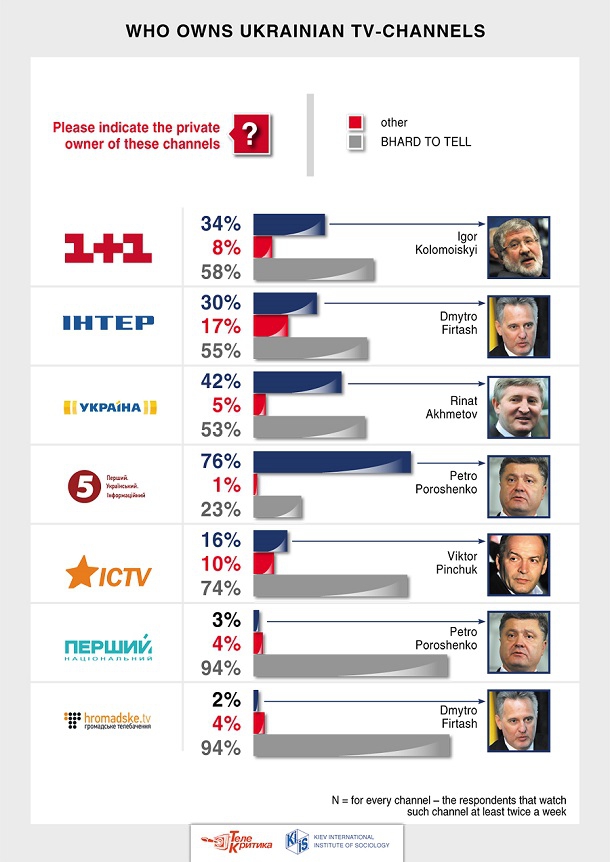
The viewers believing that the information about channel owner is important as well as those who find this information important identify much more often the owners of channels they watch.
All in all, the knowledge about specific owners that may influence the TV content of their channels is not common among Ukrainians. The interest to that is not very high either: only one third of respondents say that it is important to them to have access to such information.
Part 2. Ukrainian Media Lose Credibility, Attitude to Russian Media Deteriorated Dramatically even in the East
Ukrainian media are losing credibility almost all over Ukraine except for the Western region. At the same time, Russian media are losing credibility more intensively in the South and East as well. Only 1% of respondents in Ukraine said that they have got improved opinion about Russian media since the beginning of the year, whereas 60% have deteriorated and 28% left unchanged.
Given the harsh confrontation between Ukraine and Russia, the media are one of the most important types of influence. The information source as shown below has significant relation to the ideologemes accepted by a person. Though the majority of Ukrainians use Ukrainian TV and Internet media, there are still some people consuming Russian information product. About 22% of respondents regularly use both Ukrainian and Russian sources of information.
61% of Ukrainians get the news from national Ukrainian TV-channels every day, other 26% several times a week, 4% several times a month. The Western and Central regions watch the news on these channels more often, the Southern and Eastern less often but overall weekly coverage by Ukrainian news ranges from 84% to 95%.
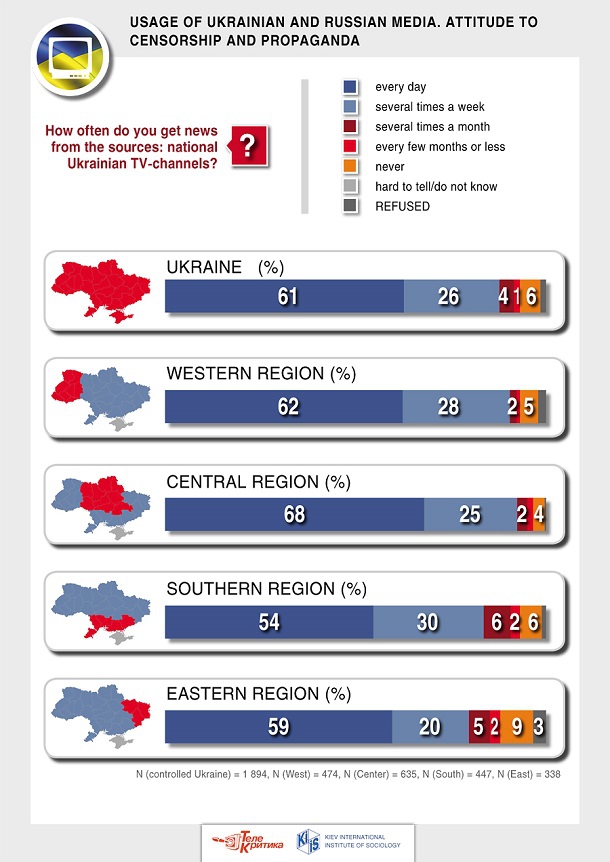
21% of respondents use Ukrainian on-line media daily, 17% - several times a week, 5% - several times a month. Little more than a half of respondents never use such media as the news source. Thus, the weekly coverage is 42%. Similarly to the national channels, the Western and Central regions read Ukrainian on-line media more often, and the Southern and especially the Eastern regions read them less.

Weekly coverage by Russian TV-news in Ukraine is 18%. The regional differences are not distinct: e.g., the West watches the Russian TV-news as often as the East. The popularity of the Russian TV must be related not only to the preferences of viewers in a certain region but also to their accessibility (due to the satellite signal, availability of illegal channels broadcasted by cable TV operators etc.). In other words, the same intensity of viewing of Russian content in different regions may be explained by its accessibility in one region and popularity in another.
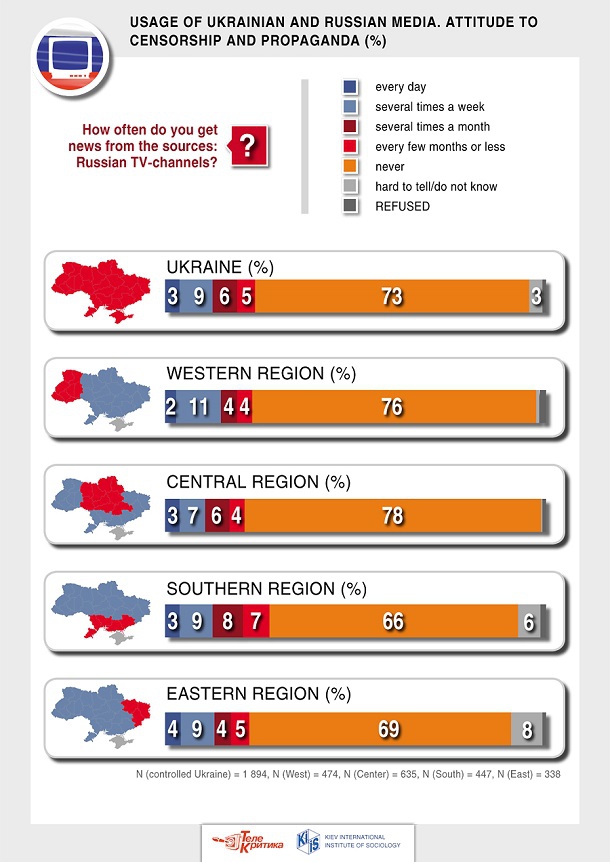
The weekly viewers of Russian Internet media in Ukraine is 23%. They are least read in the West and East, and in the Southern and Central regions the most. The relatively low audience of Russian internet media in the East is due to the lowest rate of internet-users here – 46% compared to 62% in Ukraine in general.
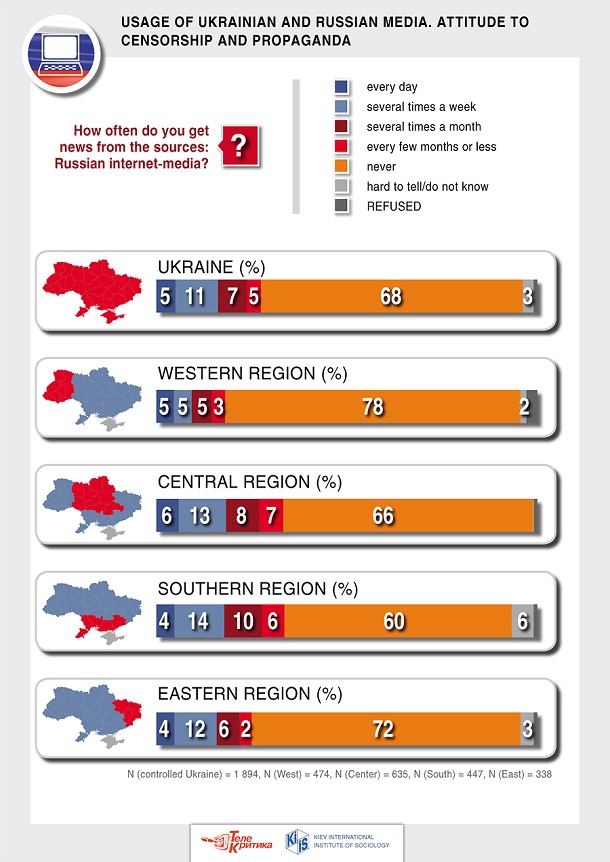
The analysis of the view rate of Ukrainian and Russian on-line media by internet-users only shows that the share of those who view Russian on-line media at least several times a week is almost the same all over the regions (except for the West): from 29% to 32% of users in Central, Southern and Eastern Ukraine and 17% in Western Ukraine. While the Ukrainian on-line media have typical audience profile: more popular in the West and less in the East.
To generalize, the information above the audience was clustered in types and frequency of read news sources. 72% get news from Ukrainian TV-channels and on-line media mainly (43% watch TV only, 29% also use Internet). 22% regularly view both Ukrainian and Russian information sources (9% of them are TV-viewers exclusively). 6% practically show no interest in news from any of the mentioned media.
Ukrainian media lose credibility almost all over Ukraine except for the Western region. In the South, East and Center, the share of respondents saying that their opinion about Ukrainian media deteriorated since the beginning of the year prevails over the share of respondents with improved opinion. Speaking about the whole Ukraine, 65% of respondents did not change their opinion, 19% deteriorated and 11% improved their opinion.
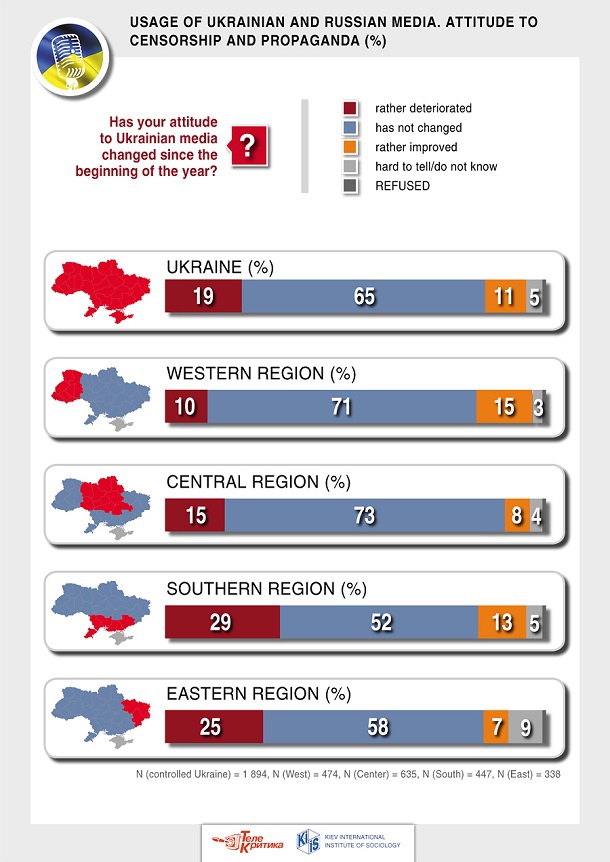
The gradual loss of credibility to Ukrainian mass media is critical in the information war, though it is compensated by much more intense decrease in credibility to Russian media in the East and South. Only 1% of respondents in Ukraine told that they improved their attitude to Russian media since the beginning of the year, whereas 60% deteriorated and 28% did not change.

Ukrainians do not have clear opinion about censorship and propaganda in mass media. On the one hand, 56% of respondents totally or rather agree that the journalists can make propaganda reports for the sake of Ukrainian State (other 22% do not agree and 21% cannot answer). The position is rather unanimous all over the regions though over one third of respondents in the East do not have clear opinion on this matter.
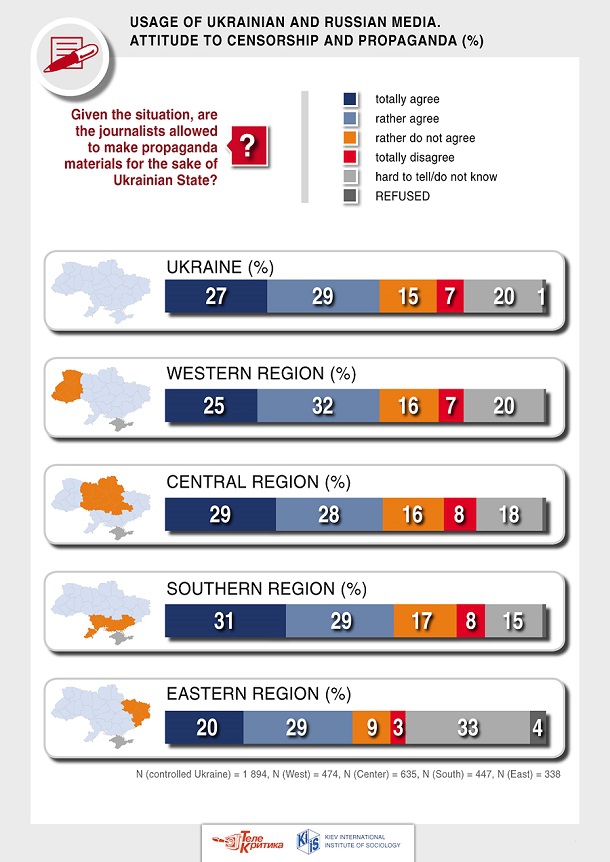
On the other hand, 54% respondents totally or rather agree that the journalists are allowed to criticize the Ukrainian army (other 24% do not agree and 21% cannot answer). This statement is more supported than not in all regions.

We have two complementing explanations to such distribution of answers. On the one hand, Ukrainians believe that the pro-Ukrainian propaganda and critics of army are not incompatible. So the journalists can do both; the propaganda is allowed but the censorship is not. On the other hand, some respondents could have understood these questions as relating to the absence of prohibitions of propaganda and critics that is to say to the freedom of speech in the country. In this case the journalists can do both propaganda and criticize army without any significant risk to pay for that.
Part 3. Implantation of Russian View of Maidan and War at Donbas Not Successful
But more subtle propaganda aimed at “rocking the boat”, which would play upon disappointment, people’s lack of trust in authorities and reforms as well aswar fatiguemay succeedas it is planted in fertile soil.
A mechanism of formulation of convictions among the Ukrainians with regard to the situation in the countryhas not been fully explored. It is known that an opiniondepends on the region of residence and national self-identity. There is also an assumption that some part of the population is influenced by the Russian propaganda that impacts their political outlook. At the same time, some questions have not been answered. In particular, whether the Russian propaganda achieves its goals in traditionally pro-Ukrainian regions, whether pro-Ukrainian environment compensates its influence (and on the contrary, how Ukrainian propaganda works in Eastern and Southern Ukraine); whether consuming Russian/Ukrainian news correlates to a higher tendencyto agree with the reality interpretation presented in the news. It is also not known which factor impacts a political position of a person to greater extend: his/her place of residence, and thus environment and factors that are specific for the region, his/her national self-identity, or influence of those media that are a source of news for him/her. To answer these questions, an additional study was carried out, which included clustering and variance analysis.
For the cluster analysis purposes, all respondents were divided into 4 groups in accordance with their practices of obtaining news from different sources:
- viewers and readers of news mainly in the Ukrainian media (nationwide TV-channels and/orinternet media) (72 %);
- consumers of both Russian and Ukrainian massmedia (TV and/orinternet) (22 %);
- viewers and readers ofnews mainly from the Russian massmedia (TV and/orInternet) (0.2 %);
- people who almost use neither Ukrainian, nor Russian internet mediaand TVto learn news (6 %).
Furthermore, respondents were divided into linguistic and ethnic groups: Ukrainian-speaking Ukrainians (52 %), Russian-speaking Ukrainians (41 %), Russians (5 %) and others (2 %).
Respondents answered the question as to which extend they agree with this or that statement concerning the Maidan, the war in Donbas, and situation in the country.Statements presented both Ukrainian and Russian propagandistic points. An average level of support for pro-Ukrainian and pro-Russian position was calculated in general and separately for every topic (the Maidan 2013-2014, hostilities in the east of the country, evaluation of the current situation in Ukraine, including ability and inability to overcome difficulties and make all the necessary transformations). Then we compared the average indicators for every region among the groups by media consumption.
The main conclusions are below:
- The use of Ukrainian and Russian news sources is really related to the level of support for a respective opinion aboutdevelopment inthe country (also within a region, and a linguistic and ethnic group). That is true to all the issues: the Maidan, the war, situation in Ukraine — andis true both for the Ukrainian and for the Russian media. Dependence of convictions on the sources of information is especially remarkable in the east and in the south. Even in the west of the country, respondents who watch Russian news and read Russian internet mediademonstrate a more moderate position than those who do not do it.In general, those who use Ukrainian information sources are more inclined to supportthe “patriotic” discourse.
- However, a region of residence is the most influential factor that determines pro-Ukrainian or pro-Russian opinions, even when people with similar practices of media usage and withthe same national self-identity are compared. For example, in the central part of the country Russian-speaking Ukrainians who learn news only from Ukrainian sources support pro-Ukrainian statement to a higher extent than those in the south.
- It should be understood that it is impossible to confirm availability and direction of a cause-effect relation between the practices of news consumption and respective views. In other words, a person can have some opinion because he/she get news from respective sources, or he/she can choose sources that support his/her views.
The study included questions concerning how the attitude of Ukrainians to the Donbas conflict participants is changing: Ukrainian army and volunteer battalions, “DPR/LPR” militants, Ukrainian and Russian authorities, the European Union leaders, and the US government.
The best dynamics of respondents’ attitude can be seenwith regard to the Ukrainian army and volunteer battalions. The attitude of 46% respondents to the army has improved, and it deteriorated for 13% respondents since the beginning of the year. For volunteer battalions those indicators are 43% and 14%,respectively. In western oblasts, the positive attitude is most remarkable while it is a little bit weaker in central, and is the weakest in southern oblasts; but everywhere the share of those respondents whose attitude to the Ukrainian military improved is much higher than the share of those whose attitude worsened. In the east, the share of those people whose attitude to the Armed Forces of Ukraine has not changed is the highest, and the rate of the attitude deterioration is a little bit higher than that of its improvement.
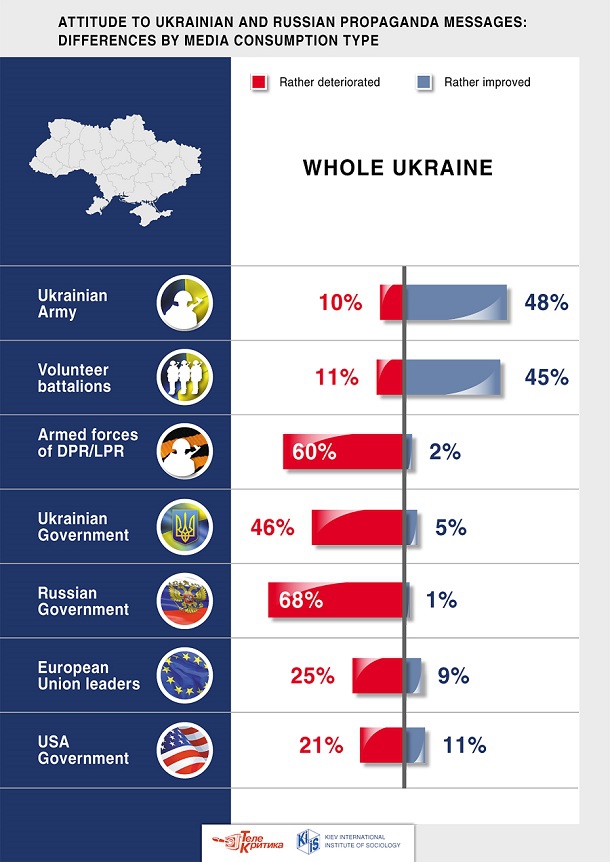
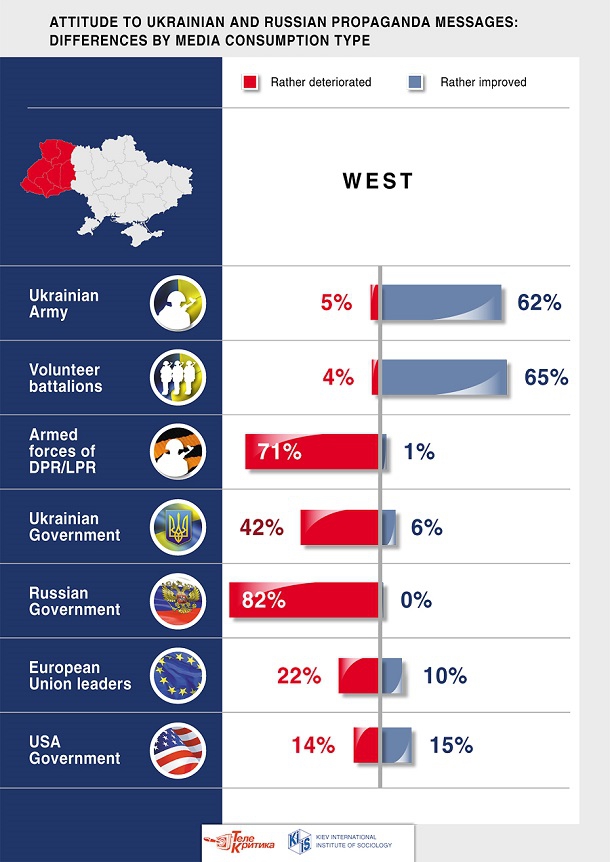
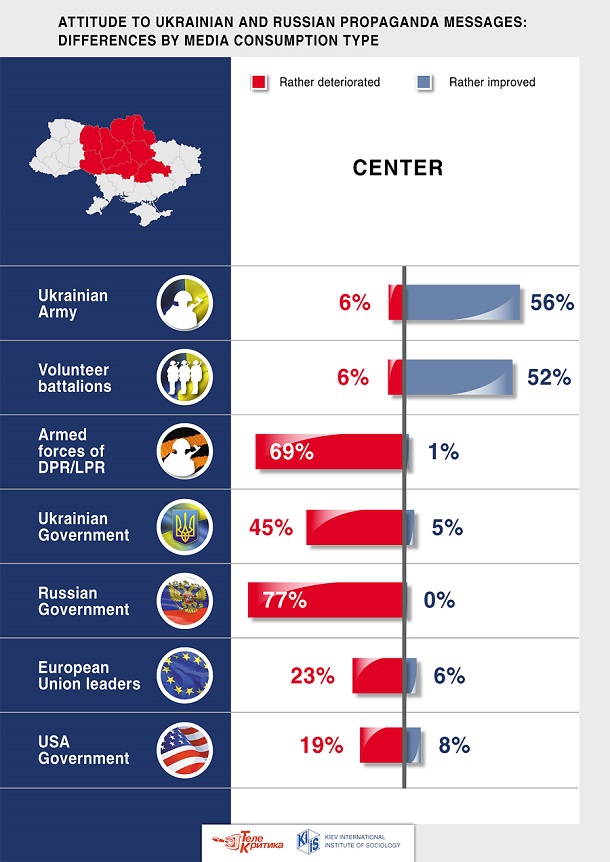

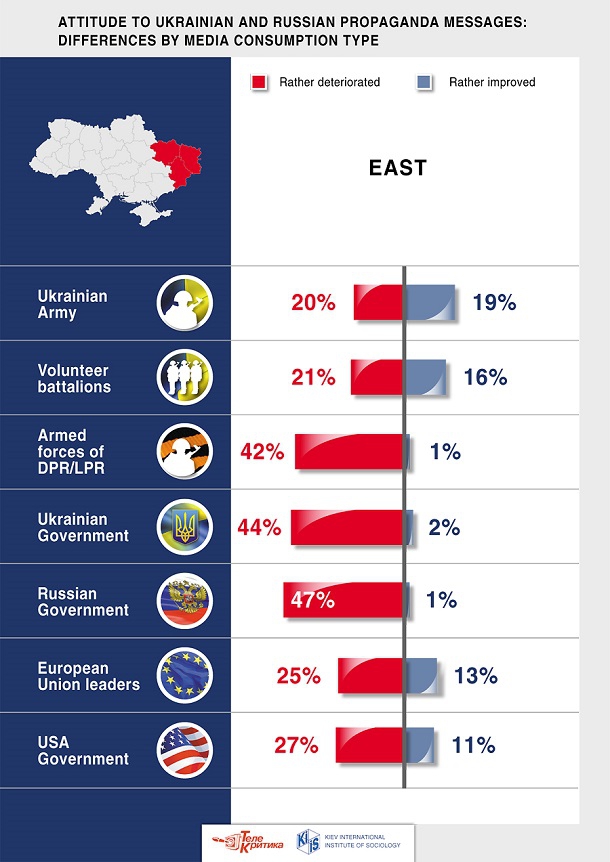
Popular attitude to all other conflict participants worsens over time. Predictably, the leadersin terms of the level of negative perception arethe Russian government and the armed forces of “DPR/LPR”. Yet, the Ukrainian government occupies the third place. In the south and in the east of the country, the attitude to it deteriorated even more than to Donbas militants. In general, 46% respondents stated that their opinion aboutthe Ukrainian government worsened since the beginning of the year, and the attitude of only 5% improved. Everything indicatesthat the Ukrainian top-ranking officials do not meetpeople’s expectations, and even traditionally patriotic regions feel disappointment and doubt. Attitude to the Western leaders changes the least over time, still some declining trends are observed.
Furthermore, the respondents answered to which extend they agree or disagree to any statement from a list containing the pointstypical in Russian and Ukrainian propaganda concerningthe Maidan, the war in the East of Ukraine, situation in the country, and its prospects.
The highest support among the Ukrainian citizens is demonstrated for such statements as: “Actions of the Ukrainian Army in Donbas is the war against Russia and pro-Russian terrorists”; “The cause of the majority of problems faced by the country is Russian aggression”;“The developments that took place in winter 2014 in Kyiv were people’s revolution”;“The incumbent government is unable to carry out the reforms necessary for the country”.
The least support was demonstrated by the Ukrainians for the following statements: “Ethnic Russians and Russian-speaking citizens are persecuted in Ukraine”; “Actions of the Ukrainian Army in Donbas are punitive actions against their own people”; “The Donbas referendum reflected the true desires of local population”.
If one compares support for various statements in different regions it can be seen that although in general the Ukrainian share a rather pro-Ukrainian opinion about the developments, assessment of the Maidan and hostilities in Donbas is the factor that mostly divides different Ukrainian regions, first of all – the East and the West of Ukraine. The least differences are observed with regard to the regions in terms of their attitude to the current situation in Ukraine, especially in the critical aspect (lack of trust in the government’s capacity to carry out reforms).
The positive statements that in the longer term are able to unite the country include the support of the need for peace even through compromises with the opponents, and the hope that Ukraine will eventually settle down to a course of development and prosperity.
The results also demonstrate that the Russian view of the Maidan and the war at Donbas was not implanted. But more subtle propaganda aimed at “rocking the boat”, which would play upon disappointment, people’s lack of trust in authorities and reforms as well as war fatigue may succeed as it is planted in fertile soil.


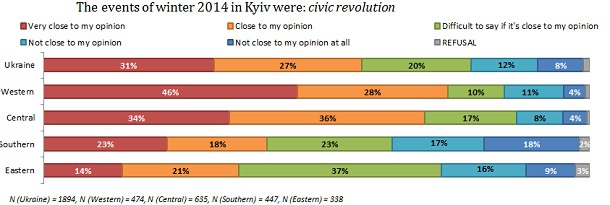
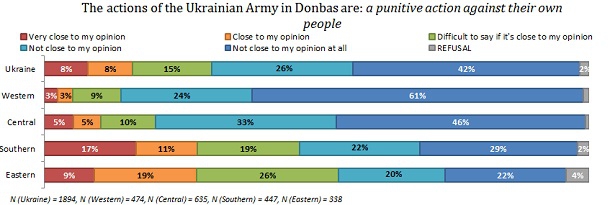
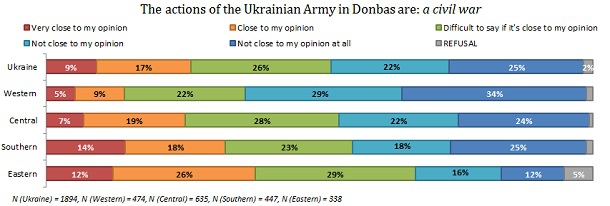






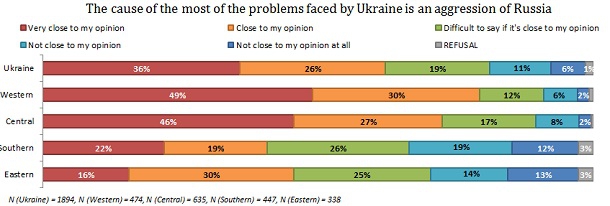
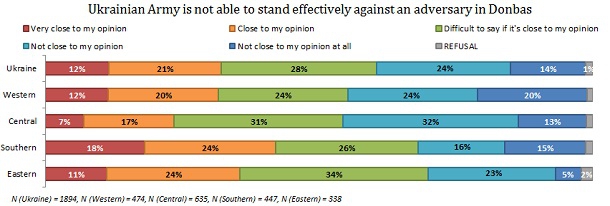
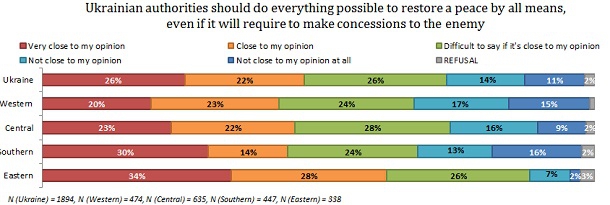
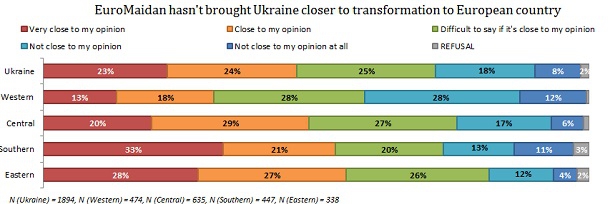
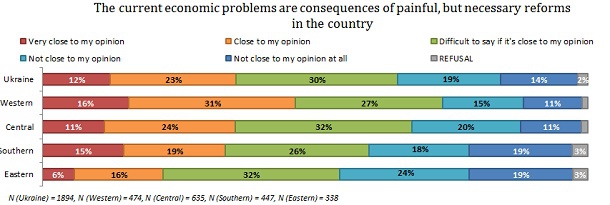
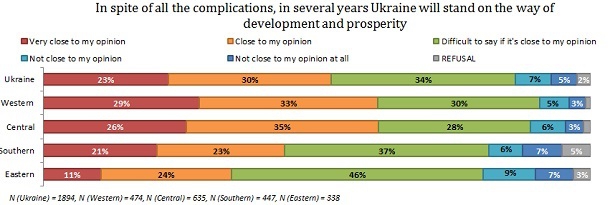
Part 4. If Local Newspapers Ceased to Exist, 51% of the Citizens Would Not Notice That
Local newspapers are not the main source of information for the population. 51% of the respondents say that if local newspapers ceased to exist, it would not impact their awareness of local news at all.
State ownership of mass media is not effective and does not assist objective and unbiased coverage of events. The activities of state media are not regulated by the principle of fair competition at the media market, while their editorial policy depends on the interests of power and its separate representatives. The next step to follow the introduction of public television and radio broadcasting should consist in the denationalization of printed press, including the one controlled by local power authorities.
One of the study’s objectives was to find out whether public feels the lack of information on the life of their community and what role local printed periodicals as they are today play in the delivery of information on local news. It will help to evaluate the target market for the renewed press and the level of population’s demand for it.
Locally, information needs of the Ukrainians are generally satisfied. One third of the respondents (32%) answer that there is quite enough information on the news of their community; other 42% answer that information is rather enough. Only 18% feel lack of local news.
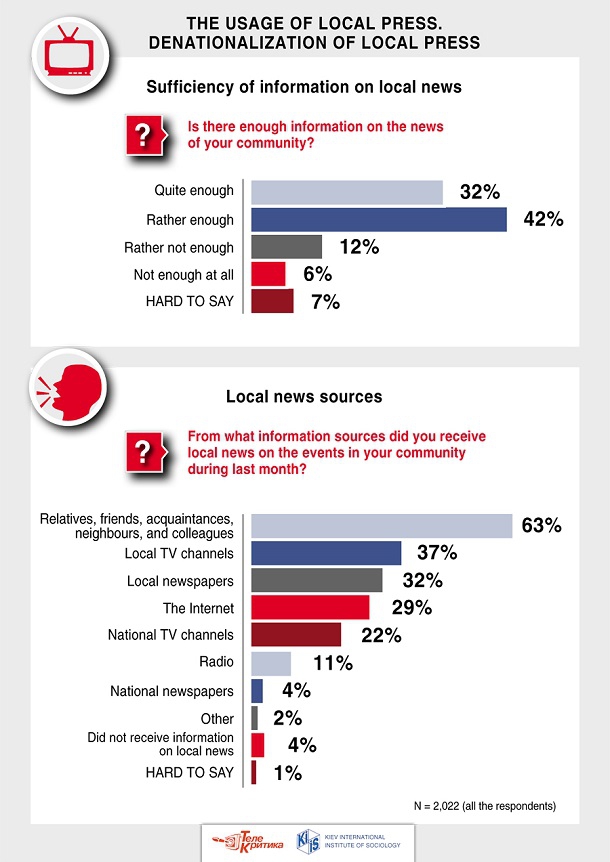
The main source of local news is word of mouth: 63% of the Ukrainians learn about the events of their community from their relatives, friends, acquaintances, neighbours, and colleagues. The second place is taken by local TV channels, used by 37% of the respondents. The third place is taken by local press, being a source of local news for 32% of the respondents during the previous month. Almost the same amount of people turns to the Internet: 29% of the respondents get information there.
In this way, during the previous month, about one third of the respondents learnt about the events in their community from local press. However, only 30% of them (and 14% of all the respondents) admit that the absence of local printed periodicals would worsen their awareness of local news. It testifies that local newspapers do not play a significant role for the majority of the Ukrainians: newspapers are read, but they are not the main or the only source of information.
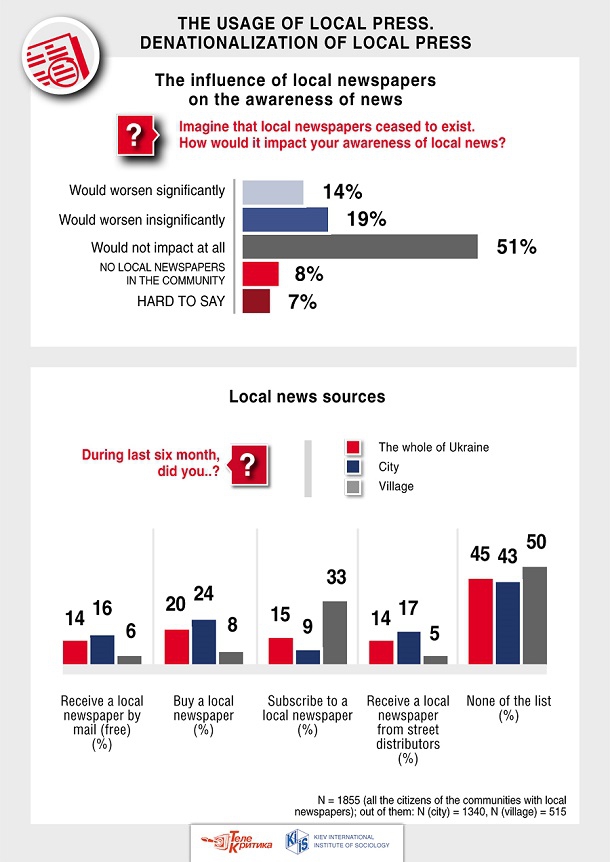
The methods to get access to local press in urban areas and in rural areas are different. City dwellers tend to buy newspapers (24% during the previous six months), receive them by mail free of charge (17%) or from street distributors (16%). Villagers, in turn, tend to subscribe to a local newspaper (33% of the villagers during the previous six months).
The habit to read local newspapers is a prerogative of older generations. For example: as for the respondents between 18 and 25, only 17% receive local news from local newspapers; as for people above 61, the amount is 43%. The representatives of older age groups are also more likely to subscribe to a local newspaper than youth.
36% of those who subscribed to a local newspaper, 21% of those who bought it, and 25% of those who received it by mail free of charge, believe that its disappearance would significantly worsen their awareness of the news of their community. In other words, the amount of those who depend on the newspapers as on the main source of local news is minor even among those who pay money for the access to this type of printed periodicals.

The data of the study testify that the Ukrainians will likely support the initiative on denationalization of printed media. 35% of the respondents (among those who have local newspapers in their communities) consider that to provide objectivity and independence, the editorial policy of a local newspaper should be determined by public. Other 32% consider that it should be determened by journalists and editors. 14% would rely this function upon the state, while only 4% would rely it on the onwer.
However, the actual situation, in the view of the respondents, is far from the ideal: 31% consider that editorial policy of local newspapers in their community is determined by a private owner; 19% consider that these are journalists and editors; 14% believe it to be the state and only 4% are convinced that it is the public.
Therefore, it is worth expecting that media reform will be taken with favour.



